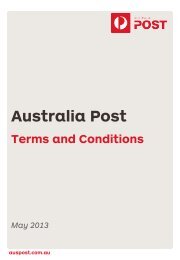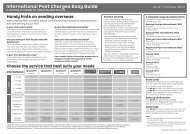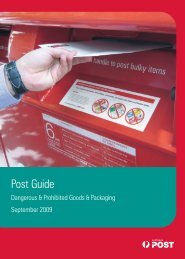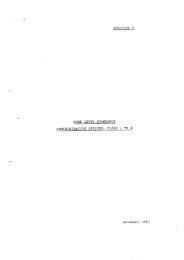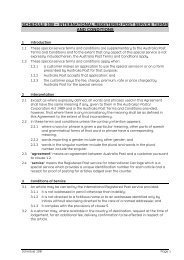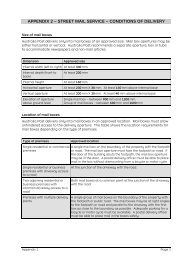2009-10 Annual Report - Australia Post
2009-10 Annual Report - Australia Post
2009-10 Annual Report - Australia Post
You also want an ePaper? Increase the reach of your titles
YUMPU automatically turns print PDFs into web optimized ePapers that Google loves.
(iv) Available-for-sale securities<br />
available-for-sale securities are those non-derivative financial assets<br />
that are designated as available-for-sale or are not classified as any of<br />
the three preceding categories. after initial recognition available-for-sale<br />
securities are measured at fair value with gains or losses being<br />
recognised as a separate component of equity until the investment<br />
is derecognised or until the investment is determined to be impaired,<br />
at which time the cumulative gain or loss previously reported in<br />
equity is recognised in profit or loss.<br />
(v) impairment of financial assets<br />
an assessment is made at each reporting date whether a financial<br />
asset or group of financial assets is impaired.<br />
(i) Financial assets carried at amortised cost<br />
if there is objective evidence that an impairment loss on loans and<br />
receivables carried at amortised cost has been incurred, the amount<br />
of the loss is measured as the difference between the asset’s carrying<br />
amount and the present value of estimated future cashflows (excluding<br />
future credit losses that have not been incurred) discounted at the<br />
financial asset’s original effective interest rate (that is, the effective<br />
interest rate computed at initial recognition). the criteria used to<br />
determine that there is objective evidence that an impairment loss has<br />
occurred include whether the financial asset is past due and whether<br />
there is any other information regarding increased credit risk associated<br />
with the financial asset. the carrying amount of the asset is reduced<br />
either directly or through use of an allowance account. the amount of<br />
the loss is recognised in profit or loss.<br />
the group first assesses whether objective evidence of impairment<br />
exists individually for financial assets that are individually significant, and<br />
individually or collectively for financial assets that are not individually<br />
significant. if it is determined that no objective evidence of impairment<br />
exists for an individually assessed financial asset, whether significant or<br />
not, the asset is included in a group of financial assets with similar credit<br />
risk characteristics and that group of financial assets is collectively<br />
assessed for impairment. assets that are individually assessed for<br />
impairment and for which an impairment loss is or continues to be<br />
recognised are not included in a collective assessment of impairment.<br />
if, in a subsequent period, the amount of the impairment loss decreases<br />
and the decrease can be related objectively to an event occurring after<br />
the impairment was recognised, the previously recognised impairment<br />
loss is reversed. any subsequent reversal of an impairment loss is<br />
recognised in profit or loss, to the extent that the carrying value of<br />
the asset does not exceed its amortised cost at the reversal date.<br />
(ii) Available-for-sale investments<br />
if there is objective evidence that an available-for-sale investment is<br />
impaired, an amount comprising the difference between its cost (net of<br />
any principal repayment and amortisation) and its current fair value, less<br />
any impairment loss previously recognised in profit or loss, is transferred<br />
from equity to the statement of comprehensive income. reversals of<br />
impairment losses for equity instruments classified as available-for-sale<br />
are not recognised in profit. reversals of impairment losses for debt<br />
instruments are reversed through profit or loss if the increase in an<br />
instrument’s fair value can be objectively related to an event occurring<br />
after the impairment loss was recognised in profit or loss.<br />
(w) derecognition of financial assets and financial liabilities<br />
(i) Financial assets<br />
a financial asset (or, where applicable, a part of a financial asset<br />
or part of a group of similar financial assets) is derecognised when:<br />
• the rights to receive cashflows from the asset have expired; or<br />
• the group retains the right to receive cashflows from the asset<br />
but has assumed an obligation to pay them in full without material<br />
delay to a third party under a “pass-through” arrangement; or<br />
• the group has transferred its rights to receive cashflows from the<br />
asset and either (a) has transferred substantially all the risks and<br />
rewards of the asset or (b) has neither transferred nor retained<br />
substantially all the risks and rewards of the asset, but has<br />
transferred control of the asset.<br />
(ii) Financial liabilities<br />
a financial liability is derecognised when the obligation under the liability<br />
is discharged, cancelled or expires. When an existing financial liability<br />
is replaced by another from the same lender on substantially different<br />
terms, or the terms of an existing liability are substantially modified,<br />
such an exchange or modification is treated as a derecognition of the<br />
original liability and the recognition of a new liability and the difference<br />
in the respective carrying amounts is recognised in profit or loss.<br />
(x) Goodwill<br />
Goodwill acquired in a business combination is initially measured at<br />
cost of the business combination, being the excess of the consideration<br />
transferred over the fair value of the group’s net identifiable assets<br />
acquired and liabilities assumed. if this consideration transferred is<br />
lower than the fair value of the net identifiable assets of the subsidiary<br />
acquired, the difference is recognised in profit or loss. Following initial<br />
recognition, goodwill is measured at cost less any accumulated<br />
impairment losses.<br />
For the purpose of impairment testing, goodwill acquired in a business<br />
combination is, from the acquisition date, allocated to each of the<br />
group’s cash-generating units or groups of cash-generating units<br />
that are expected to benefit from the synergies of the combination,<br />
irrespective of whether other assets or liabilities of the group are<br />
assigned to those units or groups of units. each unit or group of units<br />
to which the goodwill is so allocated represents the lowest level within<br />
the entity at which the goodwill is monitored for internal management<br />
purposes and is not larger than an operating segment determined in<br />
accordance with aasB 8, and includes:<br />
• Messenger post<br />
• the printsoft eletter Group<br />
• other.<br />
impairment is determined by assessing the recoverable amount of<br />
the cash-generating unit (group of cash-generating units) to which<br />
the goodwill relates. the corporation performs its impairment testing<br />
annually or more frequently when events or changes in circumstances<br />
indicate that the balance may be impaired. the corporation uses a value<br />
in use, discounted cashflow methodology for the above listed cash<br />
generating units to which goodwill and indefinite life intangibles have<br />
been allocated. Further details on the methodology and assumptions<br />
used are outlined in note 16.<br />
AustrAliA <strong>Post</strong> AnnuAl rePort <strong>2009</strong>–<strong>10</strong> | Financial and statutory reports 55




